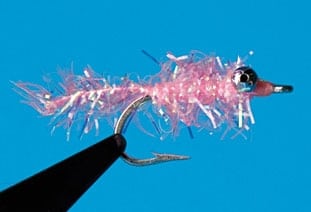
While tying Crazy Charlies and Gotchas for a bonefish trip, it occurred to me that the multiple materials used in most flies greatly complicate the tying process. Obviously, a fly that could be tied with just one material would be much simpler and quicker to tie. But would it be durable? And, more importantly, would it catch fish?
After a few abortive efforts, I arrived at a crustacean-imitating fly that fit the first two criteria of being simple and quick to tie. Ice chenille seemed ideal for a single material because it adds fish-attracting sparkle to the entire length of the pattern. It’s also easy to work with, and the core thread makes the chenille stiff enough to extend as a tail, preventing it from wrapping around the hook on the cast.
Either bead-chain or lead eyes can be used for depth control. Plus, a weed guard can be added when fishing around turtle grass or for species that frequent structure. The initial fly proved quite simple and easy to tie – and my upcoming trip with Jeffrey Pinder at Grand Bahamas Island Bonefishing would provide the perfect opportunity to find out if it was durable and if it would indeed be productive on the flats.
As it turned out, the first fish we cast to charged the fly and swallowed it with no hesitation. This happened consistently over the next two days. Every fly that we managed to get in front of a fish was eaten.
We used pink, green, white and brown versions of this fly, and all took fish. We also tried a more traditional version with a calf-tail wing as a control, but we did not see any difference in fish appeal. The durability was good, and all of the flies were still catching fish at the end of the trip.
Toward the end of our second day in the Bahamas, I remarked that this fly was obviously a keeper – but it needed a name. Pinder suggested that we name the fly after Ol’ Ernie, a reference to my fishing partner Arnie Hale. Jeffrey never made the distinction between “Arnie” and “Ernie,” and my pal had become resigned to being called Ernie throughout our trip!
I thought that the name was a great idea and said we would call our newfound pattern the Ugly Ernie.
Jeffrey immediately replied: “No man, that is one sweet fly! Let’s call it the ‘Sweet Ernie.'”
Arnie/Ernie vigorously objected to the name, which, of course, sealed the deal! Thus was born the Sweet Ernie fly. It is a very simple pattern, easy to tie and extremely durable. Best of all, it catches fish!
Next Page: Tying Instructions
Materials
HOOK: Mustad 34007 or Gamakatsu SL 45, size 2, 4 or 6
THREAD: 6/0 Flymaster
EYES: Bead chain or lead dumbbell
BODY: Cactus chenille or Estaz
WING: Optional calf tail to match body color
GLUE: Head cement, Hard as Nails
Tying Instructions
| Step 1: Tie in the eyes using X wraps, beginning approximately a quarter of the shaft length back from the hook eye. Cement the eyes with super glue or head cement. Run thread down the shaft to the curve as the tie-in point for the cactus chenille. | ** |
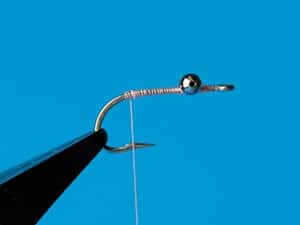
| | **Step 2: Tie a 3-inch piece of cactus chenille on top of the hook at the rear tie-in point. Create a tail by leaving a piece of chenille the length of the hook, from the eyes to the bend, extending rearward. Finish it with a half hitch and a drop of head cement or super glue. Run the thread back to just in front of the eyes.| **
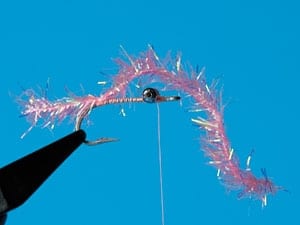
| | **Step 3: Start with a slightly backwards wrap to cover the tie-in point and then wrap the chenille forward to just behind the eyes. Run the chenille between the eyes on the bottom of the hook, and tie in front of the eyes.|
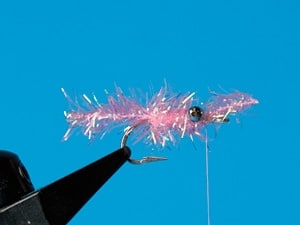
| | Step 4: Form a tapered head and coat with head cement. Finish the head with a coat of Sally Hansen Hard as Nails.|
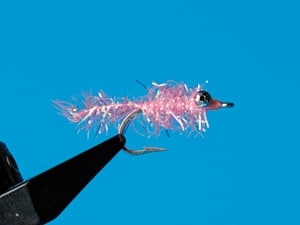
|









